JULY, 2020 NEWSLETTER
I have distinctly mixed feelings about July, although such has not always been the case. In today’s world, thanks to a variety of factors, the month comes with a lot of baggage. That includes way too much heat and humidity for my aging body, and any morning I manage to “hang on” beyond 9:30 a.m. while working in the yard or garden is exceptional. Similarly, when there is ample rain the lawn grows like gangbusters and requires mowing at least once a week. When you have upwards of two acres which requires mowing, that translates to an appreciable task. I thoroughly enjoy most outside chores and indeed find many of them mind soothing or downright therapeutic, but cutting grass isn’t in the mix. The same thing is true of weed eating. Then there are insect pests which sting, bite, want to get in your eyes, are determined to get their share of various garden crops never mind that in most cases they did nothing to contribute to the cause, and the ubiquitous squirrels, rabbits, and deer.
On the flip side July means that crops are laid by and in many cases made, and it’s a time in which the reaping of rewards from work over the previous months comes to the forefront. That means, depending on your approach along with the size and productivity of your garden, being busy and bustling first in the gathering process and then in preparing and preservation in the kitchen. Perhaps mention of what I’ve done in that regard in the last two days will serve as something of an index. I’ve gathered, shelled, cooked and frozen about a half bushel of crowder peas. You really need to stay on them every day because there’s a short window of time when pods are at their prime. Let them go from a full, fleshy, and easily opened ripeness to drying and you are losing ground. Dry pods are harder to shell and I’m convinced that removing them provides an incentive for plants to keep on bearing.
Seeds of the variety I grow were given to my wife a full half century ago, not long after we moved to the area which became a new home (though my heart will always belong to the Smokies). I’ve saved them, and in many cases shared them, through all the intervening years. If you give them support, such as planting them with corn, they’ll climb with enthusiasm. Also, as long as you do a good job of keeping them picked, they will continue to flower and bear long after the first and biggest picking has come and gone. Indeed, every year when the first heavy frost is in the offing, I go out, pick the last pods (including small ones which are broken into the shelled peas just like green beans), and save all dried pods I come across. Of course I have been saving dried ones I missed all through the summer.
Then there’s okra, which is amazingly prolific once it starts producing. As long as you keep the pods picked (or cut—I use a pocket knife) okra will continue to produce for months. As is the case with crowder peas, I save seed annually. The variety I grow was what the fellow who gave it to me called “Texas Longhorn.” I’m not sure whether that was just his name or a true variety, although I suspect the former. Whatever the case, if you let pods mature they do grow quite long and curve a bit, and I like the fact that you can slip up and let pods reach 5 or 6 inches in length and they are still tender and edible. I set one plant aside each year to save seed, always selecting one which sends out side branches and produces on them as well as the main stalk. My picking routine is on a steady 36-hour basis—early one morning and then at dusk the following day. I normally freeze okra but I’ve tried drying it this year and am delighted with the initial results. Of course the real test will come several months down the road when I see how well it does as a snack or in soup mix.
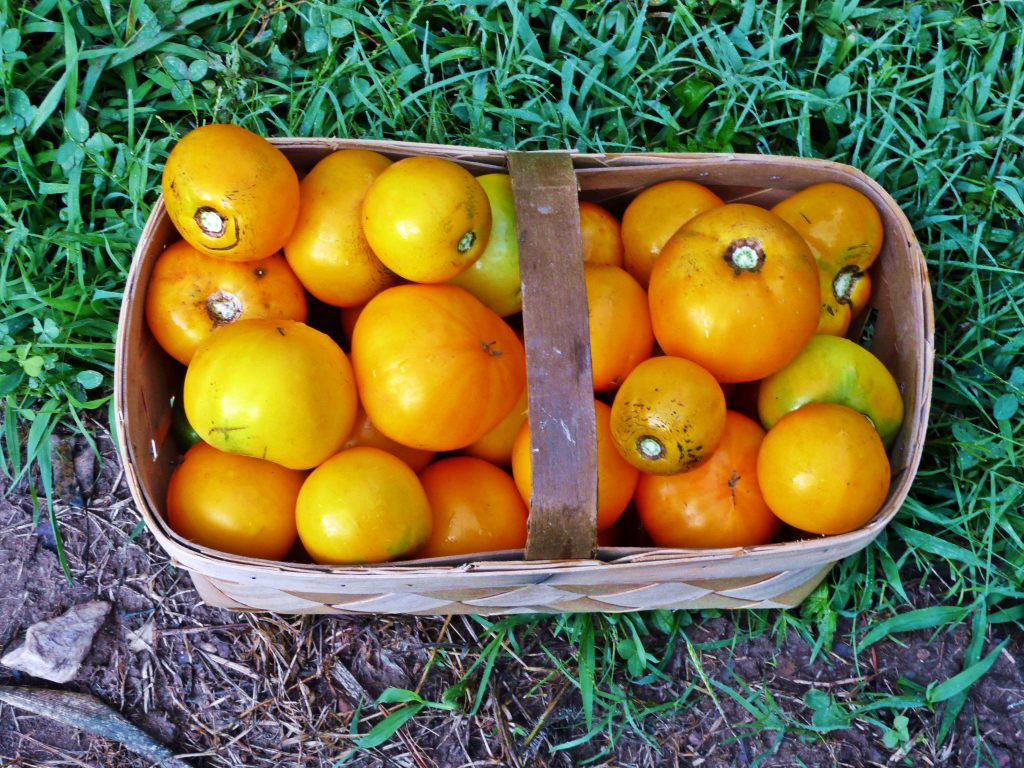
The third component of the trio which demands daily attention is tomatoes. I’m at peak production right now, and every day finds me working them up either by cutting up into chunks and freezing or (mostly) dehydrating them. It’s absolutely amazing how many dried tomatoes you can fit into a quart jar. Extras, and there are plenty of those, I’ve been giving away. Unlike zucchini and squash, I never have a problem with folks taking tomatoes.
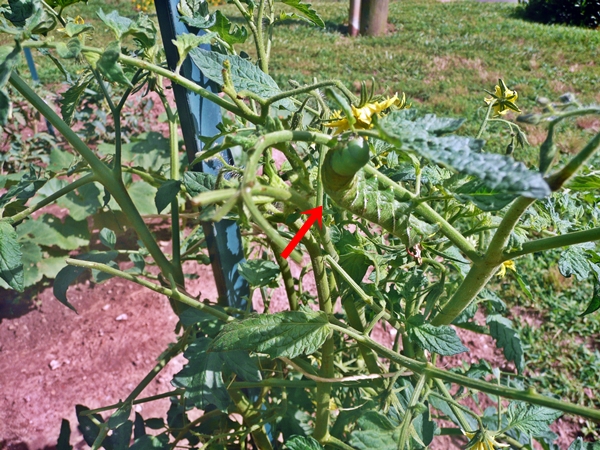
One of the many pests a gardener has to deal with, a tomato hornworm
Speaking of squash, I just pulled up all my plants. I have a recurrent problem with stem borers and somehow never seem to take the necessary steps (there are several things you need to do) to keep them at bay. I just plant every spring, harvest them in their time of abundance, and bid them a fond farewell in mid- to late July. Like okra, I’ve tried dehydrating squash for the first time this year, and I’m delighted with the end product—some lightly salted, crunchy chips reminiscent of potato chips but full of squash flavor.
Add in eggplants which produce far more than I want or need (and I can’t find anyone who will take my extras), the first planting of corn which has come and gone, and a super-abundance of ground cherries, and that’s pretty much where things stand right now. I need to gather a bunch of the ground cherries and make salsa (I’ve done it before and it’s delicious), but there’s so much to do I’ve been neglectful.
I’m still getting greasy beans and Nantahala runner beans, but I’ve pretty well let them go. I’ve already selected the vines I want for my seed saving (it should be clear by now that I’m big on saving proven winners among the things I grow), and I like to let the bean pods dry completely on the vine before picking them off in the heat of the day so there’s minimal moisture, shelling, and placing my saved seed in the freezer until planting time next year.
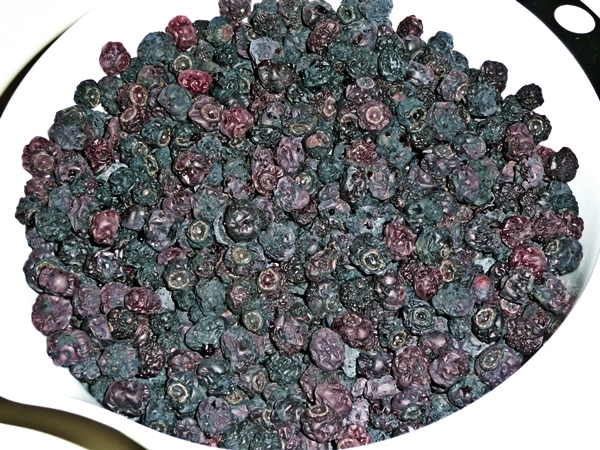
Fully dried blueberries
Beyond the realm of the garden my blueberries are in the “short rows” of production. The last of the latest varieties I have need picking now and will be gone within a week. I’ve dried all I plan to, and I’ve gotten a bit lax about picking—it’s hot, slow work and while folks gladly take any blueberries I offer, find those willing to pick on their own is an entirely different proposition.
It isn’t time to glory in what has thus far been a banner year for gardening, with rain mostly at the right time, although there was too much in May and last evening brought a deluge of well over two inches in just an hour or so, because work remains. In addition to ongoing harvesting, tomatoes still have to be tied to stakes as they continue to grow (I’ve lost several to sudden die-off, a soil condition I can’t really seem to avoid despite religious rotation), picking done daily, and most significantly, weeds kept at bay and ground prepared for late summer and fall plantings.
Another reason for July joy is that treks through the corridors of memory, something I’ve been doing a great deal of late thanks in part to a natural inclination in that direction but also because of staying at home almost all the time, bring back recollections of days, to borrow William Wordsworth’s memorable lines from his ode “Intimations of Immortality,” “of splendour in the grass {and} glory in the flower.” In my case though, it’s more a matter of splendor in mountain streams and glory in the carefree freedom of youth. July meant backcountry camping trips to catch trout, pickin’ outings for the bounty of blackberries, bike riding to nearby Deep Creek to swim and check out any tourist girls who might be there, listening to pickin’ and grinnin’ at some mountain musician’s home on Friday evenings, and the hurly-burly of hoedowns at some nearby stompin’ ground on Saturday nights. Throw in times spent with Grandpa Joe working the land or listening to him reminisce in much the same way I am doing here; carefree days on the Tuckaseigee River in the company of the area’s equivalent of Catfish John (as immortalized in song by Allison Krauss and the Nitty Gritty Dirt Band), an old river rat and convicted murderer by the name of Al Dorsey; and absorbing the swapping of lies at Dead Pecker Corner (the crude but accurate name for the local liar’s bench on the town square), and you pretty much have it. Incidentally, if you would be interested in the occasional excursion into some of the kind of characters who filled so much of my youth with wonder, let me know via e-mail (jimcasada@comporium.net). I’ve got a great many tales of folks who were, in one way or another, delightfully different.
It shouldn’t take much reading between the lines to suggest that I had an absolutely marvelous boyhood, and July was central to many of its joys. Contrast those halcyon moments with today’s doin’s, which follow below, and you’ll rightly get the sense that I yearn for yesteryear even as I manage to get much more which is meaningful done in the present.
**********************************************************************************
JIM’S DOIN’S
There have been various developments on the home front here, most of them dealing in one way or another with my writing work. Probably the biggest news involves the progress towards publication of A Smoky Mountain Boyhood: Musings, Memories, and More. I received the electronic version of the first proofs a few days ago and as this is being written the printed version is en route to me via FedEx. That means lots of careful reading, along with the rigors of preparing an index, in the days to come. If all continues to go smoothly, the finished product will be out in early November.
Although I haven’t seen it yet, the August/September issue of Smoky Mountain Living is out. It includes one of an ongoing series of food-related columns I’m writing for the publication. This one deals with tomatoes and touches on heirlooms, growing tips, and recipes. Incidentally, if you have a keen interest in the Smokies, I would highly recommend a subscription to this magazine. I’ve written for it almost from its inception, and the publication does a dandy job of covering the many facets of mountain life (details at www.smliv.com).
Speaking of coverage of mountain life, you can get a daily dose of the real deal when it comes to Appalachian ways from Tipper Pressley’s “Blind Pig & the Acorn.” I’ve mentioned this daily blog before, and in a very real sense this newsletter is coming to you thanks to Tipper. She’s my webmaster as well as a dear, cherished friend. Somehow she manages to get the newsletter out 365 days a year, and it is my morning pick-me-up even before I venture out to get the paper, do a couple of hour’s work outside, or eat breakfast. Tipper does use the occasional guest blog although the vast majority of the material is her own. I contributed such a guest piece recently (July 11) titled “In Praise of Porches.” To read it (she has all blogs archived) or to sign up to get this daily dose of mountain culture, go to www.blindpigandtheacorn.com.
Two other electronic publications you can readily access are “Making a Cane Pole Fishing Rig” (July 24) and “Dreaming of Duxbak Days” (scheduled for July 27, about the time this newsletter will head out) in “Sporting Classics Daily.” My connection with Sporting Classics magazine is of almost 40 years standing, and over time I’ve contributed scores of feature articles and book columns to the publication. The “Daily” is an offshoot and brings readers two of three interesting offerings five days a week at www.sportingclassicsdaily.com.
RECENT READING
I continue to occupy hours that heretofore would have been spent in the company of others, visiting my wife, going to ball games, and the like with a good book as a companion. I’ve always been a serious, devoted reader, but now I’m more of a bookworm than ever. My tastes are eclectic in the extreme, and I guess to some degree reading over the last month reveals as much. A goodly part of what I’ve read the last month has focused on a single writer whom I greatly admire, the Scot John Buchan (Lord Tweedsmuir). He was in some senses the father of the modern spy novel, a first-rate angling writer, and an incredibly prolific scribe who earned much of his livelihood from his literary endeavors. I’ve read all five of his Richard Hannay stories (The Thirty-Nine Steps, Greenmantle, Mr. Standfast, The Three Hostages, and The Island of Sheep); his four Sir Edward Leithen tales (The Power-House, John Macnab, The Dancing Floor, and Sick Heart River); works with a distinct autobiographical tone (Always a Countryman, Great Hours in Sport, One Man’s Happiness, and Pilgrim’s Way: An Essay in Recollection); and a biography by one of his granddaughters, Ursula Buchan (Beyond the Thirty-Nine Steps). Add in a biography of the Victorian polymath Francis Galton, and that’s pretty much it except for the beginning of a re-reading of the delightful Flashman series by George Macdonald Fraser. I’ve read them all before but they are such jolly fun and so chock full of accurate period history mixed in with the fictional misadventures of the abject coward and relentless rake, Harry Flashman (based on a bully mentioned in Thomas Hughes’ Tom Brown’s School Days, which I’ve also re-read) that I find them irresistible.
FOCUS ON DRIED FOODS
Dried foods have been a part of my life’s culinary experience as far back as my memory goes. A favorite dessert from childhood onward has been a stack cake, and most of the time the cakes were made with sauce prepared from dried apples between each of the thin layers of cake. My Grandma Minnie, long after I was grown, gone from home, and married, would still make me a stack cake any time she got work I would be home for a visit. It’s one of my fondest memories of this grand old mountain cook, and of course the apples she used were ones she had dried. Momma dried apples and peaches as well, and leather britches (dried green beans) were another common foodstuff. I even worked dried food into my backcountry camping menu long before going light when backpacking became commonplace. A package of dried apricots, when rehydrated and then adorned with some brown sugar and crumbled graham crackers, made a grand campfire dessert.
Of course the apricots were store bought, and unlike the home-prepared dry foods, they had been dehydrated. All the drying I knew growing up involved the sun’s rays, tin roofs, barn lofts, or other places which got plenty hot. For me at least, dehydrators came into the picture much later. Today though, I rely on one a great deal and I haven’t done any canning in years. I do still freeze a good bit of food, but increasingly dehydration is my way to go. It’s easy, relatively inexpensive, takes no more time than freezing and in some cases appreciably less, and the space saved is enormous. You can literally get a peck basket (or more) of dehydrated tomatoes in a quart jar if you pack them tight.
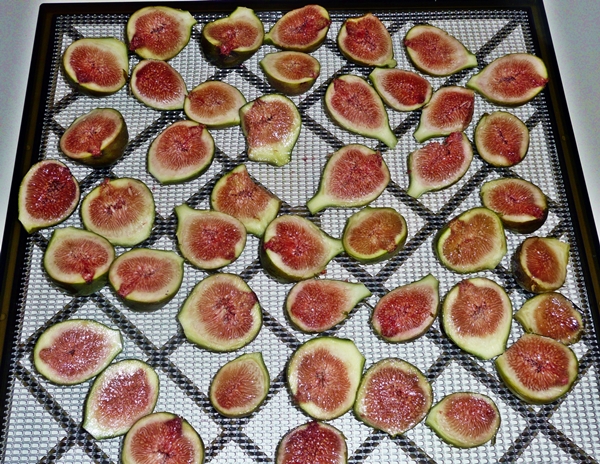
Drying figs
I use a five-tray Excalibur dehydrator and I swear by it. Mine is more than a decade old and has never given me any trouble. The trays are washable, the air flow aided by a fan makes for even drying, and there is a thermostat for temperature control as well as a timer. I did a bit of research and discovered there are larger dehydrators on today’s market, but Excalibur still has some of the highest ratings. Whatever brand you go with though, if you are a serious foodie and gardener, I strongly recommend giving food preservation through dehydration a try.
SOME GENERAL DEHYDRATION TIPS
*Use canning jars and their lids for storage, or for larger quantities turn to recycled candy or nut jars. Another possibility is the clasp-sealing jars normally used for flour, sugar, and the like.
*Immediately after you have finished dehydrating some item and placed it in a container, put the food in a freezer for a day or two. This should take care of any bacteria likely to be left after drying. If in doubt about the keeping qualities of something you have dried, just keep it in the freezer.
*Clean the drying trays after each use. Mine can be cleaned in the dishwasher.
*A pinch test is usually all you need to determine if an item is fully dried. If you can pinch any moisture out of it more time is required, but a leather-like texture, as opposed to being brittle, is fine for things like tomatoes, peaches, apples, pumpkin, candy roasters, persimmons, and the like. In fact, the very name “fruit leather,” which can be done quite nicely with a dehydrator, suggests softness and flexibility.
*”Look” your foodstuff before drying just as you would check dried beans before putting them in a pot. Cull anything suspicious and cut out bruises or bad spots in fruit or tomatoes.
**********************************************************************************
Here are some thoughts on individual foods I’ve dehydrated and how to prepare them for the table.
*TOMATOES—When drying tomatoes, toss the thin slices in a bit of olive oil before putting them in the dehydrator. That will leave them pliable, as opposed to brittle, when fully dry and thus easier to store. The end result is really the equivalent of what are called sun-dried tomatoes in grocery stores and restaurants. Used in soups or stews, chopped into bits to adorn salads, pureed in a blender with a bit of water to make paste, dotted atop pizza, featured in any number of Italian dishes, or eaten as a snack, they are the single biggest focal point of my dehydrating efforts.
*BLUEBERRIES—Just spread recently picked blueberries on the dehydrator trays and dry until they are no longer soft to the feel. You can use them atop cereal for a crunch flavor addition, rehydrate in pancake batter for blueberry pancakes, use in blueberry muffins, or even turn into scrumptious blueberry pie or cobbler.
*OKRA—Slice pods lengthwise in half or cut up in pieces after the same fashion used when frying okra. If you plan to use it as a snack, sprinkle with some sea salt before beginning to dehydrate. Dry until crisp and crunchy
*SQUASH—Slice think rounds and sprinkle with salt before beginning the drying process. Place on sheets in a single layer (which is true for anything you dry). I like the end result best as a snack, but it works perfectly well when reconstituted as a part of dishes such as a squash casserole or succotash.
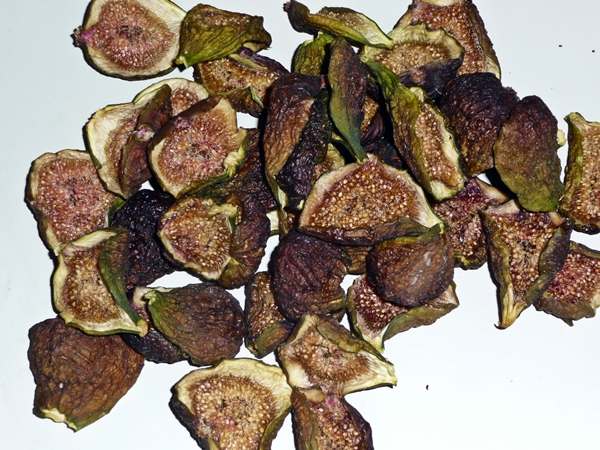
Fully dried figs
*FIGS—Clean ripe figs and cut them in half, placing the outer edge of the fig downwards on the drying trays. Dry until stiff. Delicious as a snack but also useful in pemmican or reconstituted for desserts such as fig bars.
*PERSIMMON LEATHER—I have two Oriental persimmons which bear wonderfully well every other year (they have some fruit every year but seem to follow a heavy crop, light crop schedule much like many nut trees). I freeze some of the pulp for use in pudding, but much of the harvest goes straight to the dehydrator. Just remove the skin from the persimmons (they normally don’t have seeds) and work it up thoroughly. I press the pulp through a colander to remove some of the stringy fiber and then put it in another colander to let some of the excess moisture drain off. Place the resultant pulp in a thin layer atop dehydrator trays and dry until soft and pliable.
If you haven’t tried dehydration you have a delightful new food dimension in front of you, and I think any cooking or gardening enthusiast owes it to themselves to give the process a try.